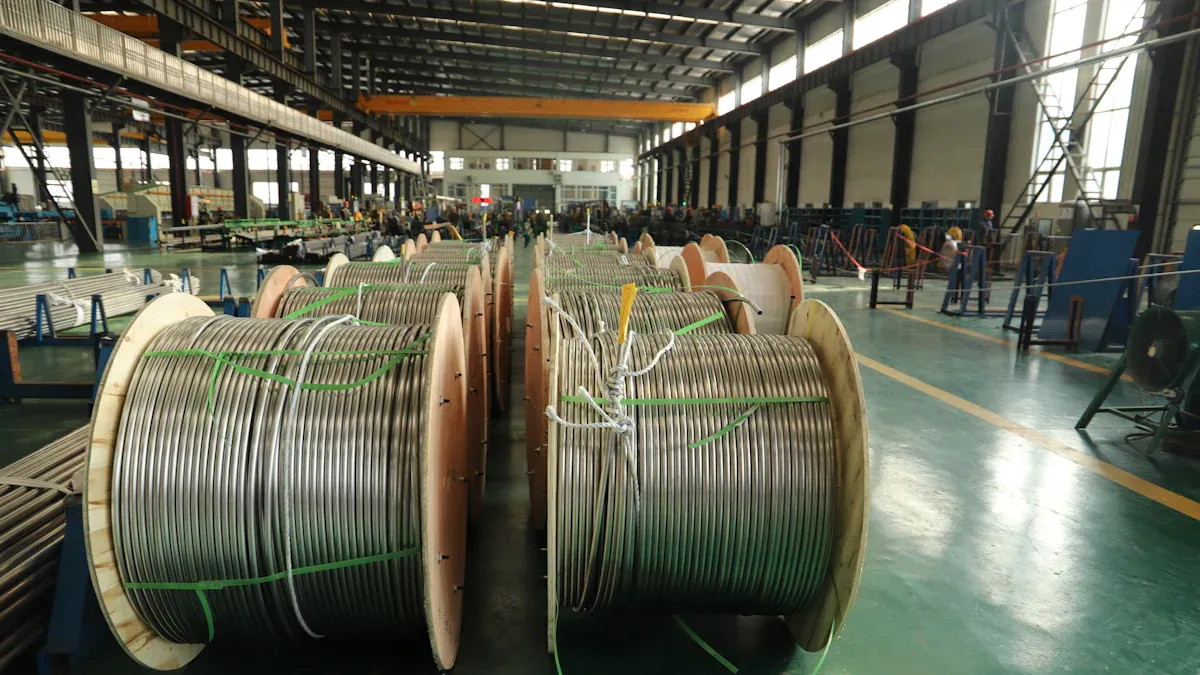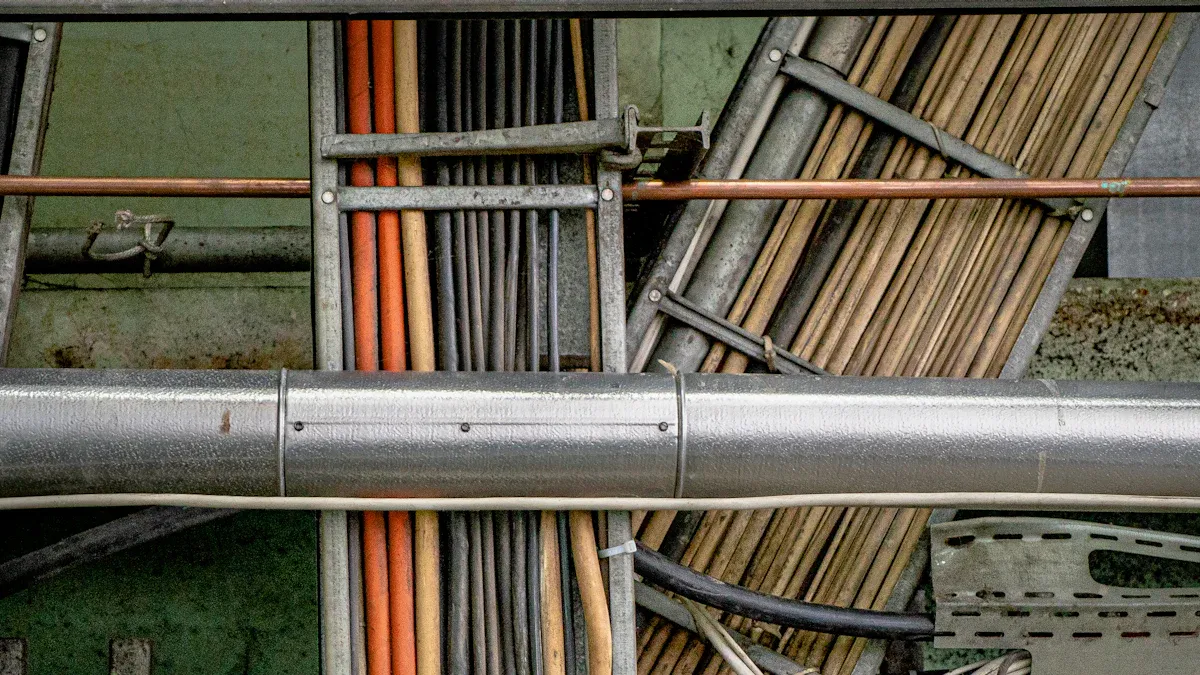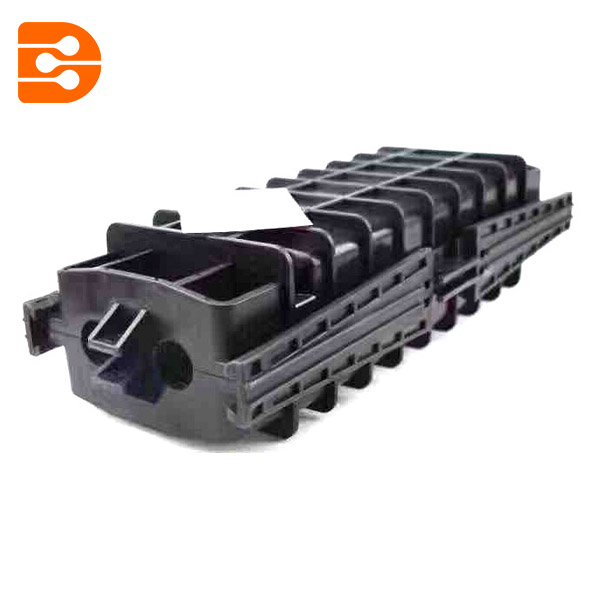
Underground fiber networks form the backbone of modern communication systems, yet they face constant threats from water damage. Even minor water ingress can disrupt operations, degrade performance, and lead to costly repairs. In 2019, over 205,000 underground telecommunications facilities sustained damage, eclipsing the combined damage of natural gas, electric, and water utilities. A single damaged facility incurred traffic disruption costs of $330,000 and took 23 days to repair.
Industrial-grade Fiber Optic Splice Closure solutions provide a robust answer to this challenge. These enclosures, including horizontal splice closure and vertical splice closure types, shield fiber optic splices from water intrusion. Options like 1 in 4 out fiber optic closure and outdoor fiber optic closure designs enhance reliability, ensuring uninterrupted network performance.
Key Takeaways
- Strong splice enclosures keep underground fiber networks safe from water.
- Special seals, like IP68-rated ones, block moisture and protect fibers.
- Installing them correctly and checking them often helps them last longer.
- Stay away from mistakes like messy cables or dirt to keep networks strong.
- Buying good splice enclosures now can stop expensive fixes later.
Understanding Water Damage in Underground Fiber Networks

Causes of Water Ingress
Water ingress poses a significant threat to underground fiber networks. Several factors contribute to this issue:
- High humidity levels in the surrounding environment can introduce moisture into underground systems.
- Water leaks in substations often seep into cable trenches, creating a pathway for water intrusion.
- Poorly sealed enclosures allow water to penetrate, leading to immediate problems like short circuits and long-term issues such as corrosion and insulation damage.
In fiber optic systems, water ingress can cause signal attenuation, connector corrosion, and mechanical damage. Freezing water exacerbates these problems by expanding and stressing the cables. Proper sealing methods, such as those used in industrial-grade Fiber Optic Splice Closure solutions, are essential to mitigate these risks.
Impact on Fiber Optic Systems
Water damage significantly affects the performance and longevity of fiber optic systems. Stress corrosion in optical fibers accelerates when exposed to moisture, especially in high-stress environments. In freezing conditions, ice formation can physically damage the fibers, leading to costly repairs and service disruptions.
Protective measures, such as gel-filled optical fiber cables and tight-buffered designs, offer some resistance to water ingress. However, these solutions are not foolproof. Studies recommend using IP67 or higher-rated outdoor closures to ensure maximum protection. Fiber Optic Splice Closure systems with advanced sealing technologies provide a robust defense against water damage, ensuring network reliability even in challenging environments.
Key Features of Fiber Optic Splice Closure
Advanced Sealing Technologies
Fiber optic splice closures rely on advanced sealing technologies to protect sensitive components from environmental hazards. These technologies enhance protection against moisture, dust, and extreme temperatures. Mechanical sealing methods, such as gaskets and clamps, improve durability by creating a robust barrier against external elements. High-performance elastomers further enhance moisture resistance and temperature stability, ensuring long-term reliability.
Some modern closures incorporate real-time monitoring systems that track temperature, pressure, and humidity. These systems enable predictive maintenance, reducing operational costs and minimizing downtime by detecting issues early. Research shows that advanced sealing technologies can reduce downtime by up to 40%, making them a cost-efficient solution for network operators.
| Evidence Type | Description |
|---|---|
| Improved Protection | Advanced sealing technologies enhance protection against moisture, dust, and extreme temperatures. |
| Increased Durability | Mechanical sealing has been improved with advanced gaskets and clamps, leading to better durability. |
| Real-time Monitoring | Innovative closures include built-in monitoring systems that track temperature, pressure, and humidity. |
| Reduced Downtime | Research indicates a 40% reduction in downtime due to early detection of issues. |
| Cost Efficiency | Predictive maintenance reduces operational costs by minimizing field visits. |
| Enhanced Performance | High-performance elastomers provide superior moisture resistance and temperature stability. |
Rugged Materials for Durability
Industrial-grade fiber optic splice closures are constructed using rugged materials designed to withstand harsh environments. Impact-resistant polymers are commonly used due to their ability to endure physical stress without compromising performance. These materials ensure the closure remains intact even in extreme conditions, such as heavy rainfall, freezing temperatures, or high-pressure environments.
The closures are also designed to accommodate various installation scenarios, including manholes, poles, walls, and buried environments. Their robust construction ensures they can handle the mechanical stress associated with these diverse applications. For example, closures with dome-to-base clamps and O-ring seals provide additional durability and protection against environmental factors.
| Specification Type | Details |
|---|---|
| Material Type | Impact-resistant polymer |
| Environmental Space | Above ground, Below ground, Buried |
| Closure Sealing Type | Dome-to-base clamp with O-ring |
| Mounting | Manhole, Pole, Strand, Wall |
| Water Resistance | Flash test valve at 5 psi (40 kPa) |
| ISO Compliance | ISO 9001:2015 |
Moisture Resistance and IP68 Ratings
Moisture resistance is a critical feature of fiber optic splice closures, especially for underground installations. Closures with IP68 ratings provide excellent protection against water ingress, ensuring reliable performance even in submerged conditions. The IP68 rating signifies that the closure can withstand continuous immersion in water at depths greater than 1 meter.
Mechanical sealing structures in these closures maintain their effectiveness even after re-entry and reuse. This feature is particularly valuable for maintenance activities, as it ensures the integrity of the seal remains intact. Additionally, these closures offer protection against UV radiation and weather-related damage, making them suitable for outdoor applications.
- Qualification Standards: IEC 60529, IP68 + 5 m waterhead
- Water Resistance: Flash test valve at 5 psi (40 kPa)
- Protection Level: IP68
- Leak-proof sealing with IP68 protection
- Excellent protection against UV, water, and weather
Fiber optic splice closures with these features provide a robust defense against environmental challenges, ensuring the longevity and reliability of underground fiber networks.
Sealing Methods in Industrial-Grade Splice Enclosures
Heat-Shrinkable Sealing Techniques
Heat-shrinkable sealing techniques offer a reliable and efficient method for protecting fiber optic splice closures. These techniques involve using heat-shrinkable sleeves that contract when exposed to heat, creating a watertight seal around the fiber optic cables. This method ensures excellent sealing performance, even after re-entry and reuse. The materials used, such as engineering PP+GF plastic, provide high strength and durability, making them suitable for harsh environments.
Heat-shrinkable sealing also enhances installation efficiency. The straightforward process saves time and reduces labor costs, making it a preferred choice for many network operators. Additionally, closures utilizing this method often achieve an IP68 protection grade, ensuring resistance to water and dust. However, this technique has limitations, including reduced adjustability and higher maintenance costs for expansions.
| Metric | Description |
|---|---|
| Sealing Performance | Good sealing performance after re-entry and re-use |
| Material | Engineering PP+GF plastic with high strength for better reliability and sealing performance |
| Protection Grade | IP68 |
| Working Temperature | -40°C to 80°C |
| Installation Efficiency | Saves installation time and improves work efficiency |
Gel-Based Sealing Technology
Gel-based sealing technology provides a versatile and user-friendly solution for fiber optic splice closures. This method uses a gel compound to create a barrier against water and environmental contaminants. The gel conforms to the shape of the cables and enclosure, ensuring a tight seal without the need for heat or specialized tools.
One of the key advantages of gel-based sealing is its reusability. Technicians can easily access the enclosure for maintenance or upgrades without compromising the seal’s integrity. This feature reduces downtime and operational costs. Additionally, gel-based closures are highly effective in diverse environments, from underground installations to aerial deployments. Their adaptability and ease of use make them a popular choice for modern fiber optic networks.
Mechanical Sealing Methods
Mechanical sealing methods rely on physical components, such as gaskets, clamps, and O-rings, to protect fiber optic splice closures from environmental damage. These methods form a robust barrier against moisture, dust, and temperature fluctuations. Mechanical seals are particularly effective in applications requiring frequent re-entry, as they maintain their sealing performance over multiple uses.
However, mechanical sealing methods can be more complex to install compared to other techniques. Proper alignment and tightening of components are crucial to ensure a secure seal. Despite these challenges, mechanical seals offer excellent durability and are well-suited for long-term installations in demanding environments.
| Sealing Method | Pros | Cons |
|---|---|---|
| Heat-Shrinkable Fiber Closure | - Reliable sealing solution | - Limited adjustability |
| - Guarantees a watertight seal | - Time durability issues | |
| - Straightforward installation process | - High maintenance cost for expansions | |
| Mechanical Fiber Closure | - Forms a barrier against environmental factors | - More complex installation |
| - User-friendly for diverse environments | - Prone to mechanical failures |
Fiber optic splice closures utilizing these sealing methods ensure robust protection and long-term reliability, safeguarding underground fiber networks against water damage.
Best Practices for Fiber Optic Splice Closure Installation and Maintenance
Proper Installation Guidelines
Proper installation of fiber optic splice closures is critical to ensuring their performance and longevity. Following manufacturer guidelines and adhering to industry standards minimizes the risk of failure. Selecting the appropriate closure type based on environmental conditions and network requirements is the first step. For instance, closures designed for underground installations must offer high moisture resistance and durability.
Technicians should also prioritize fiber management during installation. This involves organizing and securing fibers to prevent strain or misalignment. A clean work environment is essential to avoid contamination from glass fragments or dust, which can compromise the integrity of the splice. Safety standards, such as OSHA and NESC, should guide all installation activities.
Key steps for successful installation include:
- Stripping and cleaning the ends of the optical fibers.
- Securing the fibers in dedicated holders.
- Using a cleaver to execute precise cuts.
- Applying protective sleeves to preserve the splices.
- Fusing the fibers with an electric arc for a durable connection.
Technicians should also use protective gear, such as eyewear and aprons, to ensure safety during the process. Regularly checking the continuity and attenuation of cables during installation helps identify potential issues early, reducing the likelihood of future failures.
Regular Inspections and Maintenance
Routine inspections and maintenance are vital for the long-term reliability of fiber optic splice closures. Environmental factors, such as temperature fluctuations and moisture exposure, can degrade the performance of closures over time. Regular checks ensure that seals remain intact and that the enclosure continues to protect the fiber splices effectively.
Technicians should inspect closures for signs of wear, such as cracks, corrosion, or compromised seals. Cleaning the enclosure and its components during maintenance prevents the buildup of contaminants that could affect performance. Testing the network for signal attenuation and continuity during these inspections helps identify issues before they escalate.
Predictive maintenance, supported by real-time monitoring systems in advanced closures, can further enhance reliability. These systems track parameters like temperature and humidity, enabling technicians to address potential problems proactively. By incorporating these practices, network operators can extend the lifespan of their fiber optic splice closures and reduce operational costs.
Avoiding Common Installation Errors
Improper installation can significantly impact the performance of fiber optic splice closures. Common errors include failing to fully engage connectors, which can lead to performance issues, and poor field termination, which creates air gaps and increases insertion loss. Contamination on connector end faces is another frequent issue, often resulting in fiber failures.
Faulty fusion splices, caused by misalignment or incorrect polarity, can compromise the integrity of the network. Poor cable management, such as excessive bending or inadequate strain relief, may also strain connectors and lead to misalignment. Additionally, deviations from manufacturer guidelines, such as using incorrect fasteners or spacing, can void warranties and reduce the system’s durability.
To avoid these pitfalls, technicians should follow best practices, including:
- Ensuring connectors are fully engaged.
- Cleaning connector end faces thoroughly before installation.
- Using proper splicing techniques, such as fusion splicing, for durable connections.
- Managing cables effectively to prevent strain and misalignment.
By addressing these common errors, network operators can enhance the performance and reliability of their fiber optic splice closures, safeguarding their investment in underground fiber networks.
Real-World Applications of Industrial-Grade Splice Enclosures
Case Study: Preventing Water Damage in Underground Fiber Networks
Industrial-grade splice enclosures have demonstrated their effectiveness in real-world scenarios, particularly in preventing water damage. A notable case study highlights the performance of different closure types in protecting underground fiber networks.
| Closure Type | Waterproof Rate |
|---|---|
| Dome-type closure | 83% |
| Horizontal-type closure | 75% |
| Box-type closure | 45% |
Dome-type closures provided the highest waterproof rate, making them ideal for environments prone to heavy water exposure. Horizontal closures also performed well, offering reliable protection in moderately wet conditions. Box-type closures, while less effective in waterproofing, remain suitable for installations in drier environments. These results underscore the importance of selecting the appropriate closure type based on environmental factors.
In another instance, a telecom provider faced challenges while installing a high-density fiber optic network in a data center. Space constraints and the need for efficient cable management complicated the project. By utilizing splice closures, the provider safeguarded fiber splices and ensured easy maintenance. The network met all performance requirements and operated efficiently with minimal upkeep. This case demonstrates how Fiber Optic Splice Closure solutions can address diverse challenges, from water resistance to space optimization.
Lessons from Network Failures
Network failures often reveal critical insights into improving splice enclosure designs. One documented case involved a client who opted for an “equivalent” cable to meet tight installation deadlines. The cable’s behavior within the enclosure caused fiber breakage, leading to significant network disruptions. This failure highlighted the risks of using undefined equivalence in cable specifications.
Key lessons from such failures include:
- Clearly defining equivalence in terms of product characteristics and installation context.
- Avoiding shortcuts that compromise the compatibility of cables and enclosures.
- Prioritizing long-term reliability over short-term convenience.
These insights emphasize the need for meticulous planning and adherence to specifications when deploying splice enclosures. By learning from past mistakes, network operators can enhance the durability and performance of their fiber optic systems.
Industrial-grade splice enclosures play a pivotal role in safeguarding underground fiber networks from water damage and environmental stress. Their robust design ensures long-term reliability by offering unparalleled protection against mechanical stress, bending, and crushing.
- Key benefits include:
- Stable housing for optical fibers, preserving signal integrity.
- Protection from environmental factors, minimizing signal loss.
Adhering to best practices during installation and maintenance further enhances their effectiveness. By prioritizing proper sealing methods and routine inspections, network operators can ensure uninterrupted performance and extend the lifespan of their fiber networks.
Tip: Investing in high-quality splice enclosures today prevents costly repairs tomorrow.
FAQ
What is the purpose of a fiber optic splice closure?
Fiber optic splice closures protect spliced fiber cables from environmental damage, such as water ingress, dust, and temperature fluctuations. They ensure the integrity of the network by maintaining stable connections and preventing signal loss.
How does an IP68 rating benefit underground fiber networks?
An IP68 rating guarantees protection against dust and prolonged water immersion. This ensures that fiber optic splice closures remain functional even in submerged or highly humid environments, safeguarding network reliability.
Can splice closures be reused after maintenance?
Yes, many industrial-grade splice closures are designed for reusability. Features like gel-based or mechanical sealing allow technicians to access and reseal the enclosure without compromising its protective capabilities.
What are the most common sealing methods used in splice closures?
The most common sealing methods include heat-shrinkable sleeves, gel-based sealing, and mechanical seals. Each method offers unique advantages, such as ease of installation, reusability, or enhanced durability in harsh conditions.
Why is regular maintenance important for splice closures?
Regular maintenance ensures that seals remain intact and closures continue to protect fiber splices. Inspections help identify wear, contamination, or damage early, reducing the risk of network failures and extending the lifespan of the system.
Tip: Always follow manufacturer guidelines during installation and maintenance to maximize the performance of your splice closures.
Post time: Apr-24-2025

